WASHINGTON — The U.S. Air Force repelled a Chinese invasion of Taiwan during a massive war game last fall by relying on drones acting as a sensing grid, an advanced sixth-generation fighter jet able to penetrate the most contested environments, cargo planes dropping pallets of guided munitions and other novel technologies yet unseen on the modern battlefield.
But the service’s success was ultimately pyrrhic. After much loss of life and equipment, the U.S. military was able to prevent a total takeover of Taiwan by confining Chinese forces to a single area.
Furthermore, the air force that fought in the simulated conflict isn’t one that exists today, nor is it one the service is seemingly on a path to realize. While legacy planes like the B-52 bomber and newer ones like the F-35 Joint Strike Fighter played a role, many key technologies featured during the exercise are not in production or even planned for development by the service.
Still, the outcome was a marked improvement to similar war games held over the last two years, which ended in catastrophic losses. The Air Force’s performance this fall offers a clearer vision of what mix of aircraft, drones, networks and other weapons systems it will need in the next decade if it hopes to beat China in a potential war. Some of those items could influence fiscal 2023 budget deliberations.
China is “iterating so rapidly, and I think that forces us to change,” said Lt. Gen. Clint Hinote, the Air Force’s deputy chief of staff for strategy, integration and requirements, told Defense News in March. “If we can change, we can win.”
A ‘hard target’
Air Force officials talked about the classified war game’s results with Defense News in March, just months before the service is set to release its fiscal 2022 budget — its first spending request under the new Biden administration.
In similar war games held in 2018 and 2019, the Air Force failed disastrously.
The 2018 exercise involved an easier scenario in the South China Sea where the service fielded a force similar to the one it operates today; but it lost the game in record time. The following year, during a Taiwan invasion scenario, the Air Force experimented with two different teams of aircraft that either operated inside of a contested zone or stayed at standoff distances to attack a target. The service lost, but officials believed they were closer to finding an optimal mix of capabilities.
The findings helped determine what the Air Force fielded for its 2020 war game — played out by the Air Force Warfighting Integration Capability team — over a two-week period.
One breakthrough moment, recounted Hinote, occurred at the start of the game. When the officer in charge of commanding the “red team,” which simulated China, looked out at the playing field, he initially declined to move forward with an invasion of Taiwan. China considers the self-governing province of Taiwan as its sovereign territory, and has vowed to unite it with the mainland.
“The red commander looked at the playing board and said: ‘This is not rational for China to initiate an invasion, given this posture that I’m facing,’” Hinote said.
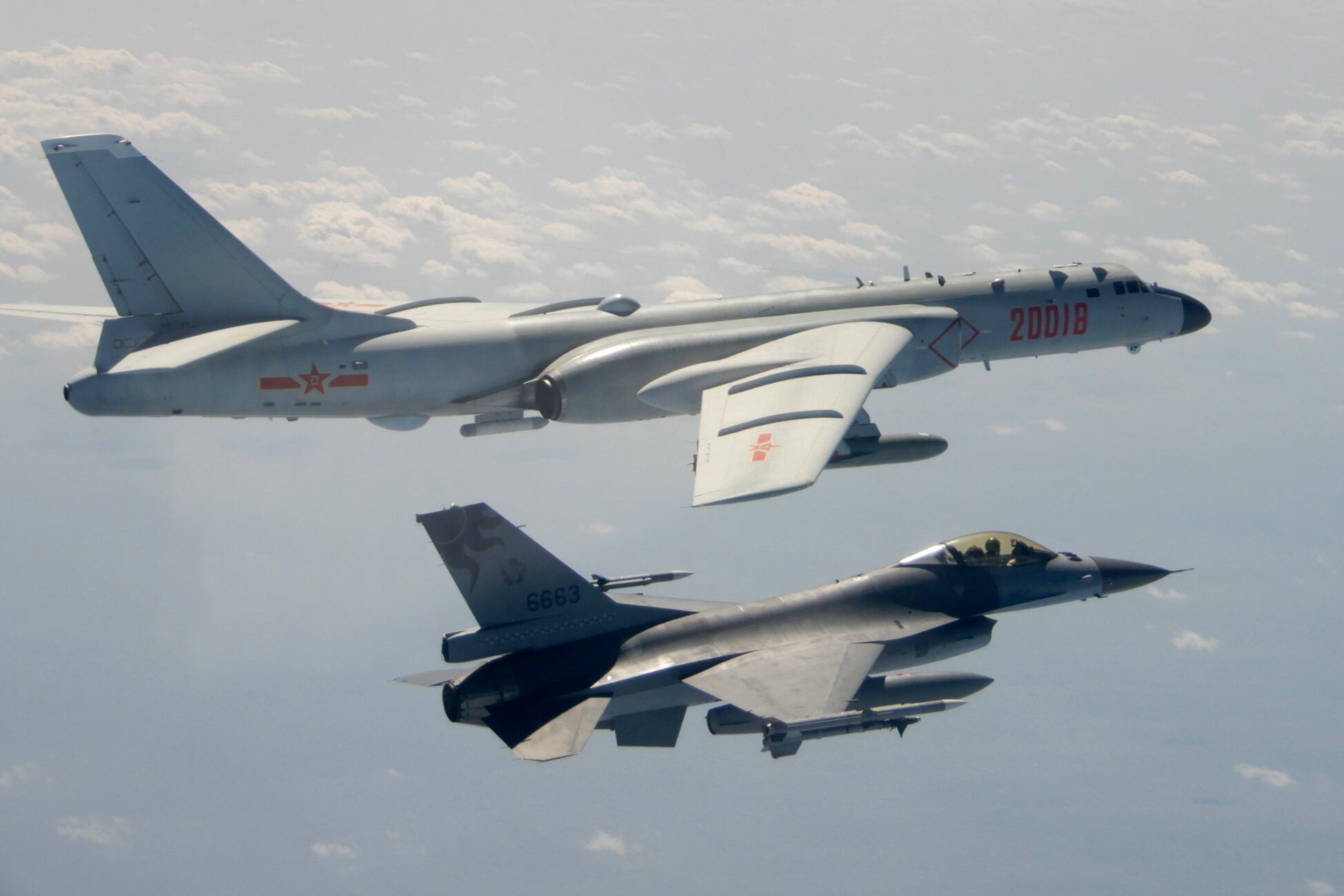
But the Air Force wasn’t going to end the war game before it even started. The red commander pushed forward with an invasion anyway.
For the war game, the Air Force made several underlying assumptions that the U.S. military and its partners will be successful in overcoming certain fiscal and technological challenges.
For example, in the service’s version of the future, the U.S. military had implemented its Joint All-Domain Command and Control concept, which would allow the armed services to send data among their previously unconnected sensors and shooters. This meant the Air Force had fielded its Advanced Battle Management System, which could work with networks and communications technologies procured as part of the Navy’s Project Overmatch and the Army’s Project Convergence efforts.
In addition, Taiwan had successfully increased defense spending as outlined by President Tsai Ing-wen, who has called for buying drones and electronic warfare equipment along with M1A2 Abrams tanks and F-16V fighter jets, as well as upgrading to its Patriot missile defense system, according to Reuters.
The U.S. Air Force also fought with a notional force that allowed it to operate different technologies that are not currently in its budget plans.
In addition, before the conflict started, the Air Force took steps to disaggregate both its operational footprint and its command-and-control structure. It made investments to remote airfields across the Pacific region — fortifying and lengthening runways as well as pre-positioning repair equipment and fuel — so that forces could deploy to those locations during a war instead of main operational bases. This approach is something the service calls “agile combat employment.”
“We tried to design ourselves where we would be a hard target. As an example, we never filled up any airfield more than 50 percent, so even if you lost that entire airfield, you wouldn’t lose your entire fleet,” Hinote said.
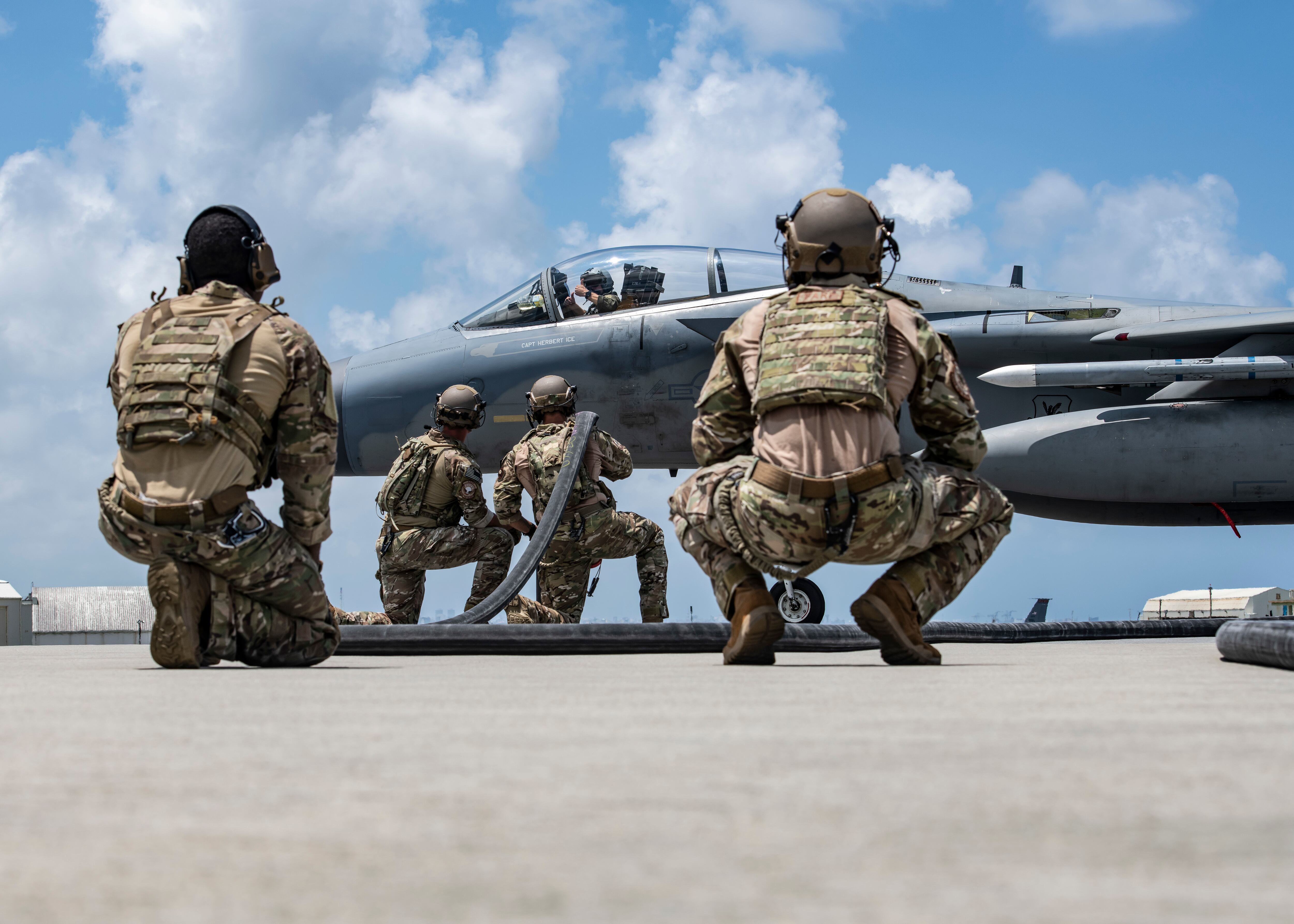
Finally, instead of separate command organizations for the land, maritime and air domains, the Air Force created small command-and-control teams comprised of five to 30 individuals from all the services. The team members were able to oversee the battlespace and direct forces using portable technology, such as hand-held tablets.
“You would pass off the command of your forces, and in a way that meant that you were not ever knocked out of the fight,” Hinote said. “They could knock [Joint Base Pearl Harbor-Hickam in Hawaii] out of the fight. In fact, they do almost every time we play this. But what they can’t do is they can’t knock out every command-and-control element that you have out there.”
Now, what has emerged is a list of what the Air Force thinks it needs to win a war after 2030:
Tactical aircraft
The air power community has been divided in recent years over how to affordably replace the Air Force’s aging tactical aircraft fleet while ensuring there are enough advanced fighters to battle the likes of Russia or China.
Should the service move forward with its plan to eventually replace the A-10, F-16 and some F-15C/D aircraft with stealthy fifth-generation F-35s? Or could a mix of F-35s and new fourth-generation jets like the F-15EX give the service more flexibility?
This disagreement heightened in February, when Air Force Chief of Staff Gen. CQ Brown floated the idea of designing a less expensive, non-stealthy follow-on fighter to replace the service’s oldest F-16s, instead of replacing them with the F-35, as had been planned for decades.
The service is currently evaluating its options through a tactical aircraft study to inform the fiscal 2023 budget, which could result in cuts to the Air Force’s program of record for 1,763 F-35As.
“We don’t have to make that decision this year,” Hinote said. However, he added, the roles each aircraft played during the war game could influence the outcome of the study “to a great degree.”
In the war game, four types of aircraft made up the Air Force’s future fighter inventory. Three of those are ongoing programs of record for the service:
- The highly advanced Next Generation Air Dominance aircraft, or NGAD, and its associated systems, which were capable of penetrating highly contested airspace.
- The Lockheed Martin-made F-35 Joint Strike Fighter, which operated as a “workhorse” aircraft attacking targets at short ranges.
- Boeing F-15EX aircraft, which mainly conducted defensive missions but were also loaded with long-range missiles and hypersonic weapons to strike targets farther downrange.
Finally, the service operated a non-stealthy, light, tactical fighter for homeland and base defense, which could also be flown in support of counterterrorism missions. That aircraft, which aligns with Brown’s idea for a “fourth-generation plus” replacement for the F-16, doesn’t currently exist in the service’s budget plans.
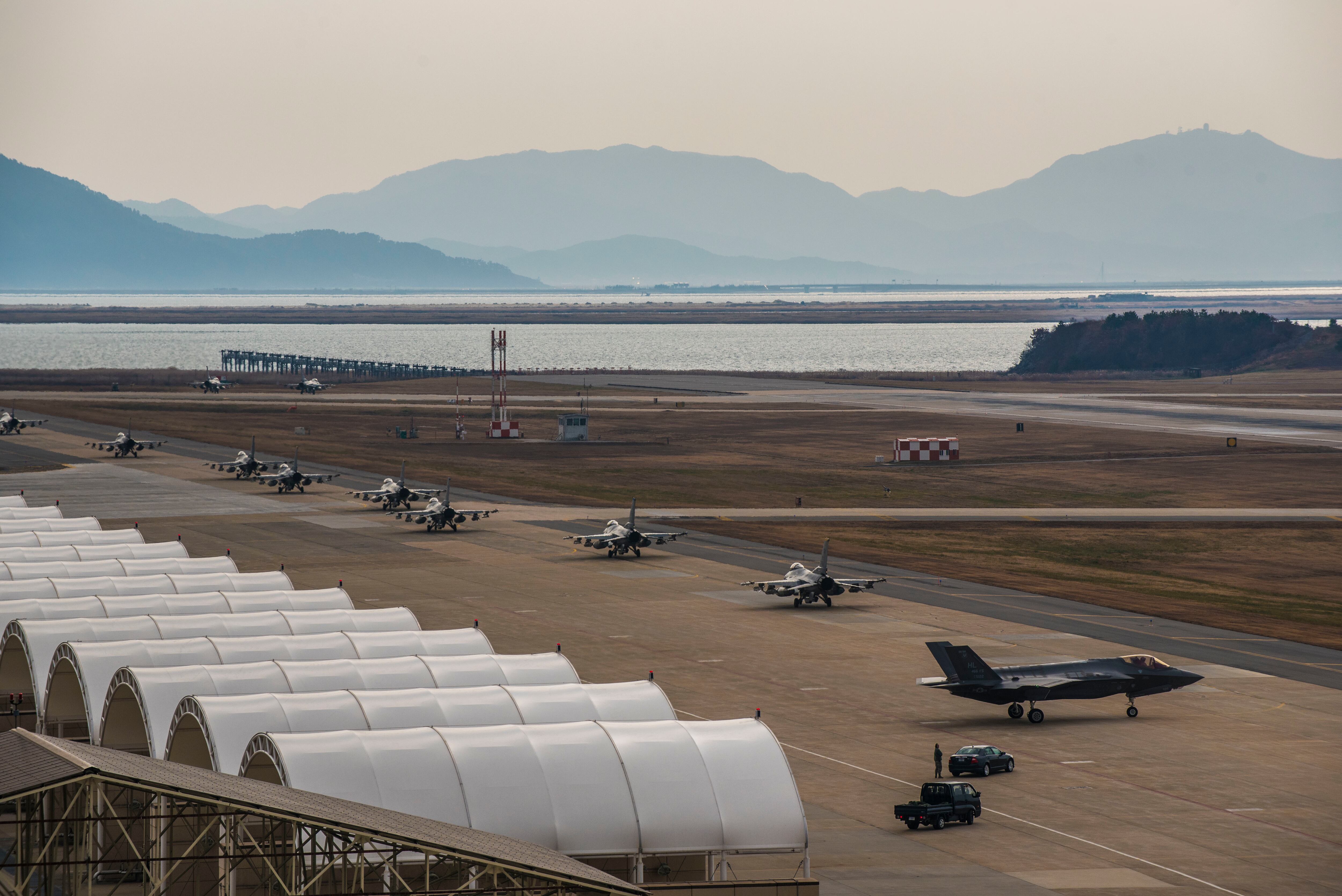
For years, Air Force officials have portrayed the F-35 as the aircraft that it would use to infiltrate into enemy airspace to knock out surface-to-air missiles and other threats without being seen. However, in the war game, that role was played by the more survivable NGAD, in part due to the F-35′s inability to traverse the long ranges of the Pacific without a tanker nearby, Hinote said.
Instead, the F-35 attacked Chinese surface ships and ground targets, protected American and Taiwanese assets from Chinese aircraft, and provided cruise missile defense during the exercise. But “it’s not the one that’s pushing all the way in [Chinese airspace], or even over China’s territory,” Hinote said.
Notably, the F-35s used during the war game were the more advanced F-35 Block 4 aircraft under development, which will feature a suite of new computing equipment known as “Tech Refresh 3,” enhancements to its radar and electronic warfare systems, and new weapons.
“We wouldn’t even play the current version of the F-35,” Hinote said. “It wouldn’t be worth it. … Every fighter that rolls off the line today is a fighter that we wouldn’t even bother putting into these scenarios.”
Drones and more drones
Much of the Air Force’s legacy drone inventory — such as the General Atomics MQ-9 Reaper and Northrop Grumman RQ-4 Global Hawk — operated in combat during the 2000s and 2010s across the uncontested battlespaces of the Middle East, where U.S. adversaries could not present significant electronic warfare or counter-air capabilities. But a war with a competitor like China some 30 years later requires more advanced and survivable drones.
For the war game, the Air Force relied on a mix of systems that are either under development or not currently sought by the service’s acquisition arm.
Autonomous “Loyal Wingman” drones flew alongside penetrating fighters in contested zones, providing additional firepower and sensor data to human pilots. Hinote pointed to Australia’s Loyal Wingman aircraft, which is produced by Boeing and flew for the first time in February, as an “impressive” capability that the U.S. sought to mirror in its war game.
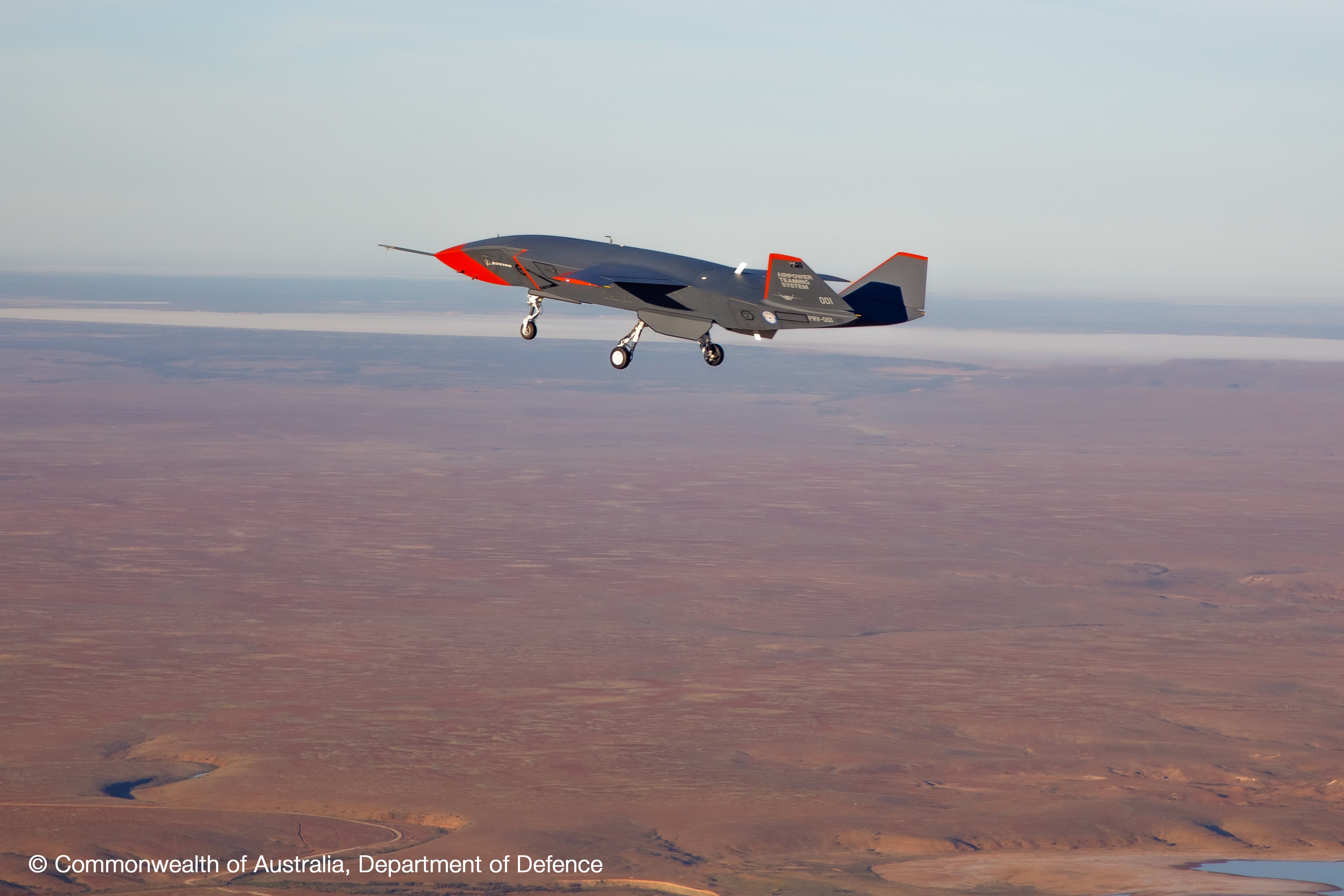
Across the Taiwan Strait, the service operated a mass of small, inexpensive drones that formed a mesh network. Although they were mostly used as a sensing grid, some were outfitted with weapons capable of — for instance — hitting small ships moving from the Chinese mainland across the strait.
“An unmanned vehicle that is taking off from Taiwan and doesn’t need to fly that far can actually be pretty small. And because it’s pretty small, and you’ve got one or two sensors on it, plus a communications node, then those are not expensive. You could buy hundreds of them,” he said.
In the second island chain, the Air Force operated low-cost attritable drones out of installations such as Andersen Air Force Base in Guam. These aircraft, like the Kratos XQ-58A Valkyrie currently undergoing tests by the service, delivered ordnance against ships, aircraft and ground-based targets. Attritable drones are cheap enough that combat losses can be endured by commanders.
Even farther out, the service flew a notional successor to the RQ-4 Global Hawk, which Hinote said would not survive a conflict with China in the mid-2030s.
Instead of concentrating on ISR, the Air Force primarily used the RQ-4 replacement as a long-range communications node, sometimes outfitting it with more exquisite radar that can track moving, airborne targets. Hinote likened the platform to an unmanned version of Australia’s E-7A Wedgetail aircraft.
“You’re using the huge aperture in there and all the power that’s there, but it’s crewed by people on the ground somewhere else,” he said. “It’s kind of a transition from where we are today to the future. You can’t do that with the E-3 [airborne early warning and control plane]; it’s just too old of an aircraft.”
Bombers, tankers and airlift
Neither China nor the United States resorted to using nuclear weapons during the war game — a consequence, Hinote said, of being able to present a credible threat to China that the U.S. has the arsenal necessary to retaliate to a Chinese strike. However, the B-21 and B-52 bombers played active roles, providing conventional firepower during the scenario, with the B-21 penetrating into contested zones and the B-52 remaining at standoff distances.
Once the war game started and the fight began, it became difficult for the Chinese and U.S. militaries to conduct airlift missions within range of each other’s missile threats. That made it critical for the U.S. Air Force to be able to pre-position food, water, medical supplies and the equipment needed run an airfield — including aircraft parts, fuel and weapons — at the locations from which it plans to operate, Hinote said.
Even though airlift assets like the C-17 and C-130 couldn’t transport cargo or people to the fight in the early days of the conflict, the aircraft still played an offensive role by launching palletized munitions that are bundled together with a guidance package and airdropped from a plane.
“One interesting thing about possible war with a peer competitor is you’re pretty agnostic as to where the fires come from; you just need the fires,” Hinote said. “I don’t want to give the impression that we’re going to create bombers out of every C-17 out there. But in certain phases of a campaign like this, you really need the extra missiles.”
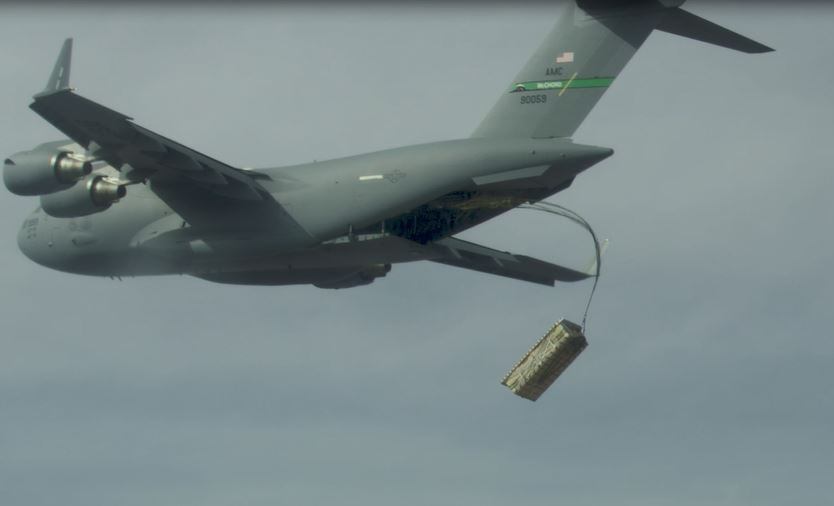
A full complement of KC-46 tankers fulfilled the aerial refueling mission during the scenario, but were kept out of high-threat environments.
The Air Force also experimented with several notional next-generation tanker designs to understand the trade-offs between fielding many small tankers capable of refueling many aircraft at a time versus operating large tankers that can carry a massive amount of fuel.
“We’re hoping that that’s going to help us as we think about what is the next step in air refueling. Do we just go buy more KC-46s? Do we look at some other type of tanking concepts and try to create a capability around that?” Hinote wondered. “I don’t have an answer for that yet because the excursions were somewhat inclusive, and they depend on a lot of things that you’re making decisions on now,” such as the mix of fighters and bombers.
What happens now?
The outcome of the war game was a United States victory, where the U.S. Air Force helped rebuff the Chinese military from taking over Taiwan. But any U.S. fight with a nation-state like China has the potential to be catastrophic for both countries.
Both the United States and Taiwan suffered high levels of attrition during the exercise, with an even higher rate of casualties among Chinese forces. Hinote declined to share exact figures due to the classification of the exercise, but said the Air Force incurred losses an “order of magnitude” lower than those projected by the service in its 2018 war game.
“The force that we had programmed, say, in 2018 took devastating losses. This force doesn’t take those devastating losses,” Hinote said. “They do take losses. We do lose a lot of airmen. It is a difficult fight.
“And that kind of gets to the point of what does it take to stand up to China in the Indo-Pacific, literally on their front doorstep. And the answer is: It takes a willingness to be able to suffer those losses. It’s just a difficult, very sobering reality that we have.”
The service plans to take its findings to Capitol Hill in the hopes of gaining the support of lawmakers for the difficult force posture decisions coming down the line in upcoming budget discussions. Brown, the Air Force’s top general, has indicated that programs could be canceled and legacy aircraft retired as the service seeks to revolutionize its technology.
But as Mackenzie Eaglen, a defense budget expert with the American Enterprise Institute, wrote in a March report, Congress has repeatedly rolled back the service’s plans to cut its existing force structure.
“This leaves the Air Force trapped in a near-term Catch-22,” she stated. “On one hand, it is trying to divest itself of decades-old legacy airframes, which drive up [operations and maintenance] costs every year, so that it can reinvest in next-generation platforms. On the other hand, its replacement aircraft programs will not be operational fast enough to meet the ongoing demands of global operations, even if the net savings from legacy divestments are sufficient to fund new platforms.”
During the war game last fall, the Air Force invited staff members from the congressional defense committees to help shape the exercise and interpret the results, hoping to pave the way for its narrative to gain traction among lawmakers.
“We’re trying to help people see the future, what it might look like, the types of choices it would take” to win a war, all keeping in mind “the evidence-based possibility that if we were able to change, we probably wouldn’t have to fight,” Hinote said. “And that’s a reason to change.”
Valerie Insinna is Defense News' air warfare reporter. She previously worked the Navy/congressional beats for Defense Daily, which followed almost three years as a staff writer for National Defense Magazine. Prior to that, she worked as an editorial assistant for the Tokyo Shimbun’s Washington bureau.




